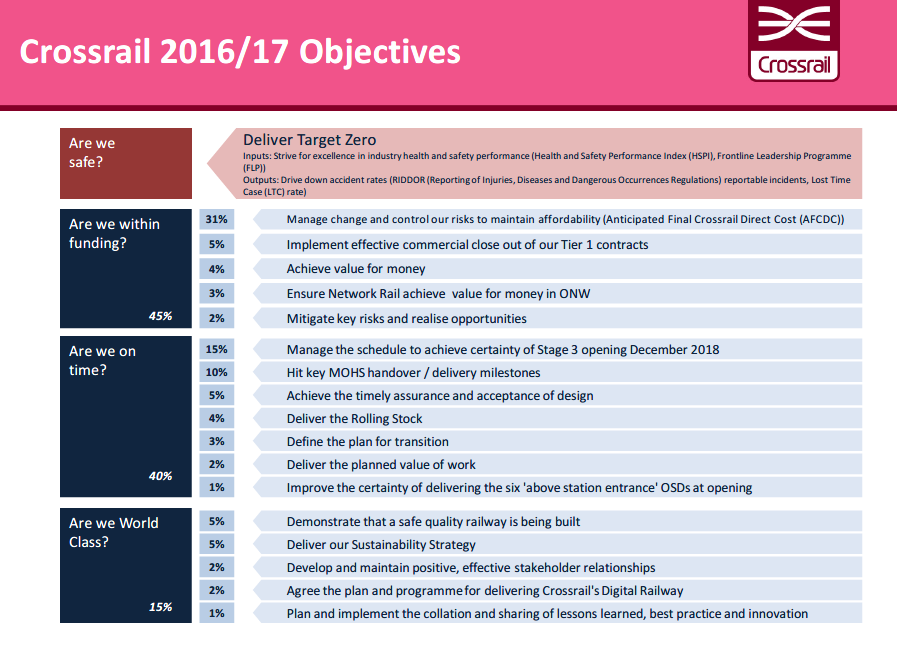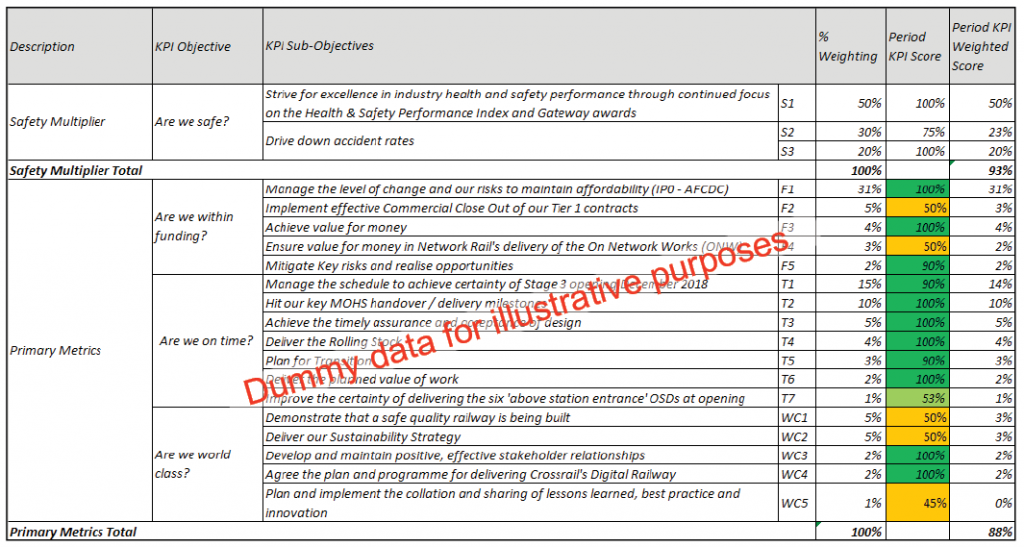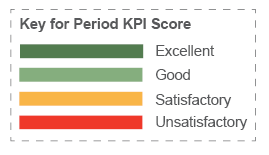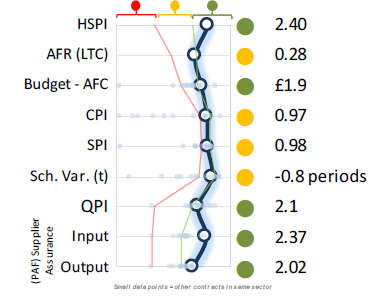
Crossrail’s Key Performance Indicators
Document
type: Micro-report
Author:
Greg Wazacz CEng MICE MEng
Publication
Date: 09/07/2018
-
Abstract
Crossrail established four key objectives on the project:
Are we safe?
Are we on time?
Are we within funding?
Are we world class?These four objectives drive all aspects involved in the successful completion of the project and form the foundations of the Crossrail Key Performance Indicators (KPIs). This micro report outlines how Crossrail’s KPIs are established and flow down throughout the project to the Crossrail team and key partners, and what lessons can be learnt.
The report would be of benefit to any major project looking to identify ways to improve performance and ensure the Key Performance Indicators are relevant and appropriate throughout the organisation.
-
Read the full document
Introduction
Crossrail Ltd established four key measures on the project: Are we safe? Are we on time? Are we within funding? Are we world class?
These four measures drive all aspects involved in the completion of the project. It is these four objectives that form the foundations of the Crossrail Key Performance Indicators (KPIs)
Figure 1 – Crossrail Objectives
Establishment and Communication of Annual Crossrail KPIs
Crossrail Ltd reports on a financial year that is divided into four quarters. In the fourth quarter of each year, Crossrail KPI objectives are defined for the following financial year. These objectives are recommended by the integrated programme-management team and approved by the Crossrail Executive Committee and Board. Objectives are developed in line with the four key measures (above), based on SMART principles (specific, measurable, achievable, relevant, and time-bound). KPIs are focused on what is important for the success of the project for the year – both in terms of achieving cost and schedule targets for the year, but also putting actions in place to de-risk future activities. Given the long duration of a project such as Crossrail, establishing KPIs on a year-by-year basis ensures a much better understanding by all levels of the organisation about what is critical to the overall programme’s success.
At the beginning of the first quarter of the financial year the KPI objectives for the year are rolled out across the project. A Crossrail Leadership Briefing Pack is developed, which includes a definition of the KPIs for the year. This is cascaded to all employees and contractors on the project. In addition, the Crossrail KPIs are published on the Crossrail intranet site (Figure 2) and posted around all offices and project sites.
Figure 2 – Communication of Crossrail KPI objectives through the Crossrail intranet site.
Crossrail KPI Scores
The KPIs are evaluated and structured against the priorities of the project. Figures 3 and 4 show examples of how the Crossrail KPI scores are calculated. Each KPI objective has a number of sub-objectives, which are cascaded through the organisation.
The sum of the sub-objective weightings for Are We Safe? totals 100%; the sum of the weightings for the remaining sub-objectives, known as primary metrics (Are We Within Funding? Are We On Time? Are We World Class?) also totals 100%. Each reporting period the sub-objectives receive a score between 0 and 100% based on the measured performance against the established measurable criteria. The primary metric scoring range is defined as an Unsatisfactory, Satisfactory, Good, or Excellent percentage, and is colour coded accordingly.
Figure 3 – Example of Crossrail KPI scores for a representative period.
The safety multiplier score is calculated as the sum of the Are We Safe? sub-objective scores multiplied by their weightings. The primary metric score is calculated as the sum of the primary metric sub-objective scores multiplied by their weightings. The Overall Crossrail Performance Score is calculated as the primary metric score multiplied by the safety multiplier.
Figure 4 – Example of Overall Crossrail Performance Score calculation for a representative period.
(Scores are solely for illustrative purposes.)For each period a KPI score is calculated, and a summary version of this is published in the Crossrail Period Board Reports. The periodic KPI scores provide an indication of how well the project is progressing against the objectives throughout the year. The final KPI score for the financial year is based on the year-end KPI score.
Applicability of Crossrail KPIs
The KPIs incentivise both Crossrail and its key partners. Crossrail Ltd uses the KPI scores to evaluate annual incentive schemes for its key partners. This helps to drive aligned behaviour throughout the organisation to encourage everyone to work towards achieving high KPI scores.
Flow Down of KPIs to Key Partners
Each year the key partners prepare annual service delivery plans that are agreed with Crossrail Ltd and form the basis for the year’s staffing plan. The annual service delivery plans are based upon the resources (people, grades, experience, location, and duration), and include the KPIs. The key partners have KPIs incorporated by Crossrail Ltd into their annual service delivery plans as a basis for awarding an annual incentive fee. These KPIs are the same as the KPIs that are applied for Crossrail Ltd. By being aligned with the same KPI objectives, Crossrail Ltd, and the key partners are motivated to work collaboratively and effectively together to successfully deliver the project.
Each financial year the key partners are entitled to a KPI interim earned amount, which is calculated as a percentage of the cost (as specified in the terms and conditions of the key partner’s contract) of their service delivery plan at the beginning of the year multiplied by the % KPI score at the end of the financial year, known as the Interim KPI score. Of this interim earned amount, 25% is paid annually, known as the interim incentive scheme, and 75% is reserved for the final incentive scheme. The final incentive scheme has specific measurable cost and schedule KPIs that give a pain/gain share for earning the final incentive. The cost KPIs are based on Crossrail completing within a certain cost threshold, and are applied at project completion. The schedule KPIs are based on Crossrail completing within specific key milestone dates, and are applied both incrementally, based on completing intermediate milestones, and at project completion, based on completing the final project milestone.
Flow Down of KPIs to Contractors
Not all KPIs on Crossrail are directly flowed down to contractors. There are a number of other project control indicators that are used to measure contractor performance for safety, quality, cost, schedule, and other parameters. These indicators are reviewed on a period-by-period basis, and used to both motivate and evaluate contractor performance. Figure 6 shows representative customer KPIs used on the Crossrail project.
One example where KPIs are flowed down to contractors is the Health and Safety Performance Indicator (HSPI). The HSPI was created for Crossrail to have a way of presenting a number of individual H&S measures, which measure both leading indicators (systems, processes, and procedures) and outputs (performance metrics) to give a single H&S performance score. HSPI is measured for each contract on the project, and is also measured at the overall project level and included as one of the Crossrail KPIs.
Figure 5 – Example of contractor KPIs.
Lessons Learned and Applicability to Other Future Projects
This is an example of where safety objectives have been flowed down throughout the organisation from Crossrail Ltd through to the Project Delivery Partner and then through to the contractors. Therefore, a good HSPI performance by a contractor directly contributes to a good KPI score for Crossrail Ltd and the key partners. This same concept applies to the Quality Performance Indicators (QPIs) and Testing, Commissioning, and Handover Performance Indicators (TCHPIs) on the Crossrail project.
The use of KPIs on Crossrail has demonstrated that the alignment of objectives between the client and its key partners is an effective driver of behaviours and outcomes. This alignment can be designed to accommodate any number of procurement strategies in a manner that would cascade down through the supply chain. The extent that they are used as the basis for incentive fees is solely at the discretion of the client, though the experience on Crossrail is that this is a very effective way in which to apportion appropriate risk through the award of fee to KPIs.
A number of lessons learned can be taken from Crossrail’s experience:
- A clear overarching vision and associated objectives from the client, underpinned by specific KPIs that flow down the supply chain, will positively influence these desired outcomes.
- A rigor in the regular assessment of status and achievement of KPIs needs to be incorporated into the project-controls procedures from the onset of a project.
- Measurable KPIs can be evaluated at a detailed level and appropriate frequency (e.g., monthly or quarterly) to allow more visible and effective management of a complex programme.
- Overarching KPIs should be adjustable as the project evolves in order to meet the changing needs and demands of a complex programme.
- Using SMART KPIs (specific, measurable, achievable, relevant, and time-bound) does make a difference.
- Making KPIs and the status transparent and visible around the project can be a good motivator of performance.
- KPIs should be designed to allow cascade or flow down through the project organisation and supply chain, with meaningful actions at each level. This results in improved employee engagement and all staff knowing their role in delivering the customer’s needs. It generates a feeling for staff of being valued and understanding their contribution to the success of the programme as they can see the logical progression through the organisation.
- Goals should be established that are within control of the team to achieve, and the constant review and reporting of objectives means that issues are highlighted and can be mitigated earlier on.
- KPIs foster pinpointed conversations on behaviours and performance (both to reward good performance and to identify and address opportunities to improve).
- Designing incentive schemes that afford an opportunity to recover lost KPI incentives can sustain a longer-term focus and performance.
- The programme works to deliver the clearly defined needs and expectations of the customer therefore leading to improved customer and stakeholder satisfaction
- Individual employee performance and salary/bonus planning can also be tied to achievement of quarterly objectives.
- It is essential that a no-blame culture is created where KPI holders feel able to ‘raise their hand’ early in the event that they need help to achieve a KPI. This creates a “we-all-win-together-or-lose-together” culture.
Conclusion
This micro report has explained how KPIs are used on the Crossrail project to establish objectives and measure performance. This has demonstrated that aligned objectives amongst all the key stakeholders involved on the project: Crossrail Ltd, the key partners and the contractors has contributed to the success of the project to date.
The selection, measurement, and evaluation of the KPIs enabled a process to be devised which could be used to reward the stakeholders on the project through incentives and remuneration.
Based on the learning outlined above the key is to have a clearly defined vision with associated objectives that enables specific KPIs to be defined. Reviewing these on an annual basis keeps them current and appropriate for the various stages of the project. For any project this provides clarity and a clear emphasis both internally and externally about what is critical to the project’s success.
Instilling a sense of ownership in employees and allowing them to take responsibility for their own part of the project, linked to the overall KPIs that they can see are cascaded through the organisation, drives performance and creates a collaborative approach.
Incorporating an incentive scheme for a contractor that provides an opportunity to recover lost KPI incentives can sustain a longer-term focus and performance, and maintains the sense of collaboration needed to achieve the overall results, even when delays or issues occur.
For any large or complex projects, getting project wide engagement with the KPIs, working towards the overall outcome is essential to achieving a successful project. Devising and implementing an appropriate KPI programme which includes Client, Partners and Contractors needs to be incorporated from the outset. Effective design and incorporating an incentive structure can then be a driver of good performance and effective collaborative working.
-
Authors
Greg Wazacz CEng MICE MEng - Bechtel
Greg Wazacz joined Crossrail in March 2016 as Stakeholder Delivery Manager. In his role he is responsible for managing the prime contract between the Project Delivery Partner and Crossrail Ltd. He is also responsible for business planning, performance management, logistics, traffic management, security and six sigma.
Greg started his career with Bechtel in 2001 and since then has worked on numerous construction projects such as High Speed 1 and Great Western Route Modernisation Program in UK, Hamad International Airport in Qatar, copper mining projects in Chile and motorway projects in Eastern Europe. He has worked in programme controls, prime contracts, and six sigma.
Greg is a chartered Civil Engineer and a Certified Six Sigma Black Belt.





